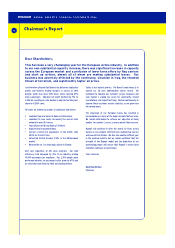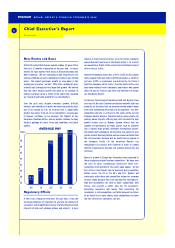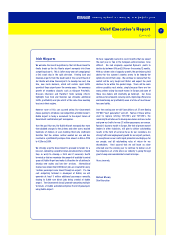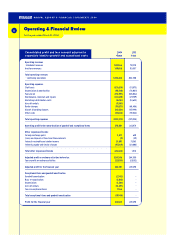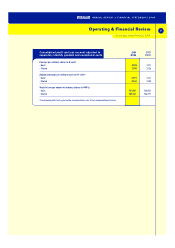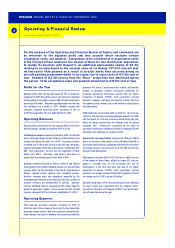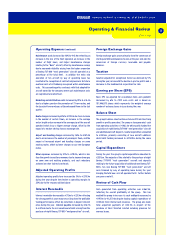Ryanair 2004 Annual Report Download - page 14
Download and view the complete annual report
Please find page 14 of the 2004 Ryanair annual report below. You can navigate through the pages in the report by either clicking on the pages listed below, or by using the keyword search tool below to find specific information within the annual report.
Review of Business Activities and
Fut u r e Dev e l o p m e nts in the
Business
The group operates a low fares airline business and plans to
continue to develop this activity by expanding its successful
low fares formula on new and existing routes. A review of the
group’s operations for the year is set out on pages 8 to 13.
Results for the Year
Profit for the financial year amounted to 206.6m. Details of
the results are set out in the consolidated profit and loss
account on page 30 and in the relatednotes.
Share Capital
The number of shares in issue at March 31, 2004 was
759,271,140.
Accounting Policies
The accounting policies followed in the preparation of these
consolidated financial statements for the year ended March
31, 2004 are consistent with those followed in the previous
financial year.
I nt e r n ational Fi n a n c i al Re p o rt i n g
Standards
Under current European proposals, the group will be required
to adopt International Financial Re p o rting Sta n d a rd s
(“IFRSs”) incorporating International Accounting Standards
(“IASs”) in the preparation of its consolidated financial
statements from April 1, 2005. The international standard
sette r, the International Accounting Sta n d a rds Bo a rd
(“IASB”), has undertaken an extensive exercise to develop
new standards and improve existing ones.
Some of the principal policy and disclosure changes required
and expected to impact on the group’s results underIFRS are
set out below.
Business combinations, intangible assets and goodwill
The more significant policy changes resulting from the
transition to IFRS include:
•Re p l a cement of goodwill amort i sation with an annual
impairment test; and
•A broader definition of “inta ngible assets” to be
recognised at acquistion.
Financial instruments
The adoption of IAS 32 and 39 (revised) will require all
derivatives to be recognised on the balance sheet at fair
value. Subsequent changes in fair values are either taken to
equity, ifthe criteria for hedge accounting are met, or to the
i n come sta te m e n t. Previously deriva t i ves qualifying as
hedges in accordance with Irish GAAP have been held off
balance sheet and the fair value disclosed within a note to
the financial statements. Any derivatives embedded within
the terms of con t ra c tual co m m i t m e n t s that are not
considered closely related to the underlying host contract
will also be separately identified and fair valued.
Deferred tax
Deferred tax is to be recognised at acquisition as part of the
fair value exercise and will be provided on some balances
previously excluded from provision under Irish rules such as
revaluations and fair value adjustments.
Employee benefit schemes: post retirement and share
option remuneration
IAS 19 requires companies to recognise the full deficit (or
surplus) of defined benefit pension schemes on the balance
sheet, but permits a choice whereby companies can choose
to either defer actuarial gains or losses within a defined
range (the corridor approach) or, as expected in any revised
IAS, can recognise all actuarial gains or losses directly
through equity inthe balance sheet.
Under IFRS, options granted by the group to employees are
to be fair valued at grant date using an option pricing model
and charged through the income statement over the vesting
period of the options.
for the year ended March 31, 2004
Directors’ Report
14
A N N U A L R E P O RT & F I N A N C I A L S T A T E M E N T S 2 0 0 4


